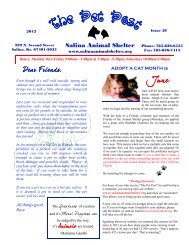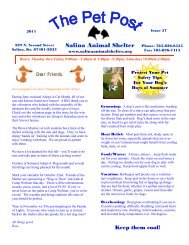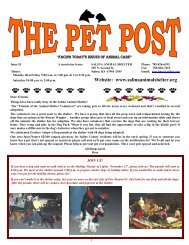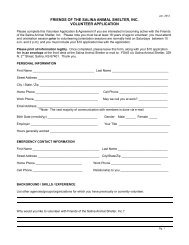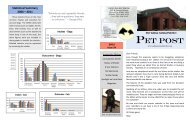PET MEMORIALS - Salina Animal Shelter
PET MEMORIALS - Salina Animal Shelter
PET MEMORIALS - Salina Animal Shelter
You also want an ePaper? Increase the reach of your titles
YUMPU automatically turns print PDFs into web optimized ePapers that Google loves.
CLUES TO DETECTING FLUFFY AND<br />
FIDO’S PAINFUL SECRETS<br />
To protect themselves from predators, animals naturally hide<br />
their pain. Your pet may be suffering even though he isn’t<br />
showing obvious signs. Advancements in veterinary science<br />
has decoded subtle telltale signs of animal distress.<br />
Observing your pet’s behavior is vital to managing his or her<br />
pain. How well do you know your pets? Use these five<br />
clues from the American <strong>Animal</strong> Hospital Association<br />
(AAHA) to help you understand your pet’s body language.<br />
Clue 1 – Abnormal chewing habits<br />
If your pet is showing abnormal chewing habits, such as<br />
dropping its food or chewing on one side of the mouth, it<br />
may have a dental disorder or a mouth tumor. Additional<br />
signs may include weight loss, bad breath or excessive face<br />
rubbing. Routine dental checkups are important to prevent<br />
and treat dental disorders and related pain.<br />
Clue 2 – Drastic weight gain or loss<br />
Pain directly influences your pet’s weight and eating habits.<br />
<strong>Animal</strong>s carry excess weight have an increased chance of<br />
tearing ligaments and damaging joints. Pets with arthritis or<br />
muscle soreness may not want to access their food because<br />
bending over is uncomfortable. Arthritis pain may also<br />
cause pets to gain weight while their eating habits remain the<br />
same due to lack of exercise.<br />
Clue 3 – Avoids affection or handling<br />
Did Fluffy used to be active and energetic, but now sits<br />
quietly around the house? Avoiding affection or handling<br />
may be a sign of progressive disease such as osteoarthritis or<br />
intervertebral disc disease. Although your pet may appear to<br />
be normal before petting or handling it, the added pressure<br />
applied to its body may expose sensitive and painful areas.<br />
Clue 4 – Decreased movement and exercise<br />
Arthritis or degenerative joint diseases (DJD) is the most<br />
common cause of pain. Pets that limp may be reluctant to go<br />
up or down stairs, exercise, or play. Weight and joint<br />
injuries can also go hand-in-hand. Losing unnecessary<br />
pounds will help overweight pets decrease pressure on sore<br />
joints and reduce pain. Consult your veterinarian about<br />
exercise, diets and pain medications that can help improve<br />
your pet’s health.<br />
Clue 5 – “Accidents”<br />
Pet owners often believe that “accidents” are a result of<br />
behavioral issues. Although behavioral issues may cause<br />
unwanted surprises, going to the bathroom in inappropriate<br />
places may be caused by pain. Pets with sore joints or<br />
arthritis may not make it to a convenient location due to<br />
painful obstacles like stairs.<br />
Urinary tract infects also may cause a messy situation. In<br />
addition to having “accidents,” symptoms of a urinary tract<br />
infection may include, lethargy, fever, tender lower abdomen<br />
and difficulty urinating.<br />
The lack of verbal expression does not mean that your pet is<br />
not experiencing pain. Minor behavioral change can be<br />
cause for alarm. Being aware of your pet’s habits can help<br />
you and your veterinarian assess and treat your pet’s pain.<br />
7<br />
CATARACTS<br />
Cataracts are one of the most common eye problems<br />
affecting pets. They can affect all breeds and ages of dogs<br />
and cats, but the condition is found more commonly in<br />
certain dog breeds, such as Cockers, Poodles, Miniature<br />
Schnauzers and Terriers.<br />
The normal, transparent lens in the eye focuses beams of<br />
light onto the retina so that your pet can see clearly. A<br />
cataract is a disruption of the normal arrangement of the lens<br />
fibers that interferes with sight by partially or completely<br />
blocking the clarity of the lens. A cataract may be quite<br />
small and not significantly interfere with your pet’s vision,<br />
but if the cataract becomes dense enough, vision may be lost.<br />
It is not unusual for your pet’s eyes to become slightly bluegray<br />
as they age. As a normal part of the aging process, the<br />
lens becomes thicker, making the eyes appear grayer. This<br />
condition, called nuclear sclerosis, usually occurs in dogs<br />
over six years of age and typically does not affect their<br />
vision. Therefore treatment for this condition is not<br />
recommended.<br />
Cataracts can be hereditary or due to old age. Inherited<br />
conditions are the most common cause of cataracts and may<br />
be present at birth or develop when the animal is very young.<br />
They can also be caused by injury, or illness such as<br />
diabetes. If you pet’s cataract are due to an underlying<br />
condition such as diabetes, treating the condition may<br />
diminish the cataracts.<br />
There is no effective medical treatment for cataracts.<br />
Cataracts are not painful, but when your pet has trouble<br />
navigating due to vision loss, his sight can be restored to near<br />
normal through surgery. A veterinary ophthalmologist will<br />
surgically remove the lens, replacing it with a plastic or<br />
acrylic prosthetic lens to allow for more focused vision.<br />
Cataract surgery generally has a 90-95% success rate, but it<br />
is also a very delicate procedure that requires extensive<br />
postoperative care by the pet owner.<br />
After surgery, your pet will have to wear a protective collar<br />
(Elizabeth Collar) until his eye heals and you will need to<br />
keep him quiet and calm. Your pet will also require eye<br />
drops to be administered several times a day for a few weeks.<br />
You and your veterinarian can decide if cataracts are<br />
affecting your pet’s vision enough to warrant surgery. For<br />
more information, consult with your veterinarian.



